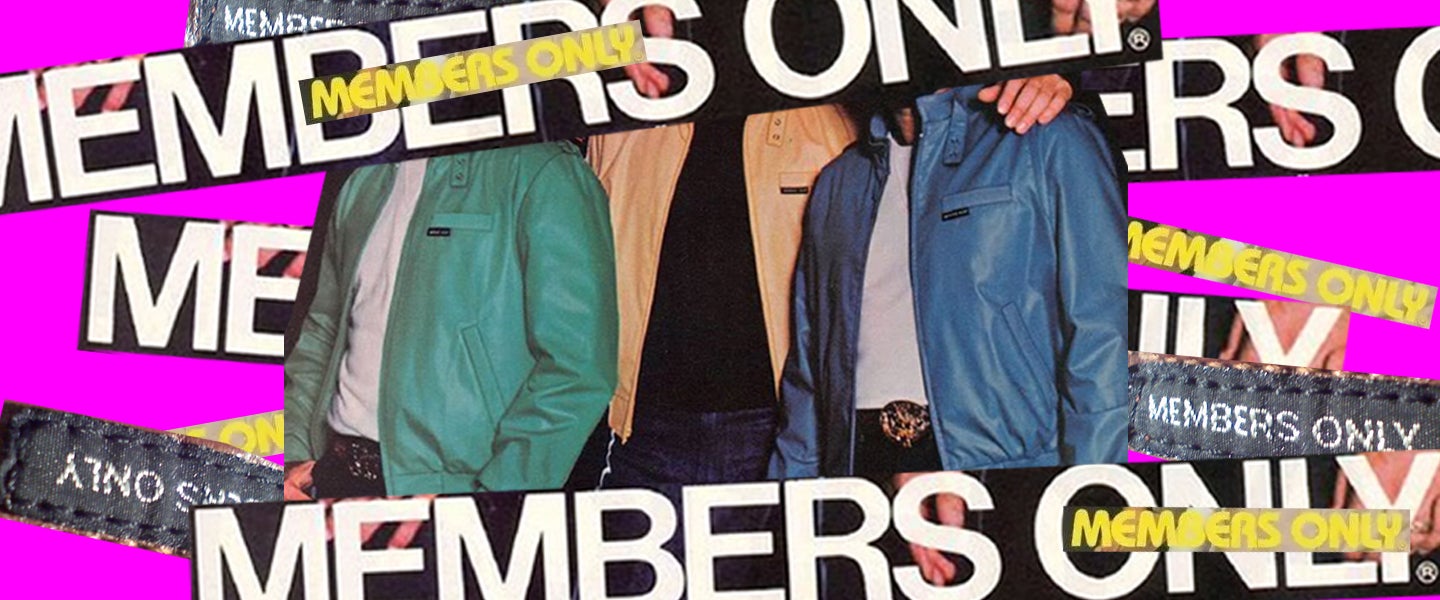Few items of clothing have stood the test of time like the Members Only jacket. Whether you were an original purveyor of the 65 percent polyester, 35 percent cotton jacket back in the 1980s, or part of the millennial hipster generation that brought it back in the early 2000s, one thing has always been clear: There’s just something about this simple jacket that makes it eternally relevant. After all, like the tagline says, “When you put it on, something happens.”
To learn more about the persistence of this stylistically basic item of clothing, we spoke to everyone from the current owner of the brand to a Sopranos superfan. Enter, please — no jacket required.

The Inception
The early days of the Members Only jacket are nebulous. Though the jacket’s unique features were developed in Europe, it was its introduction into the U.S. market by Europe Craft Imports in 1979 that would help make it iconic.
Ron Malhotra, current owner of Members Only: The jacket was designed in Europe in 1975 when the brand was created. It was brought to the U.S. in 1979 and became a huge success. I don’t have knowledge as to who designed it and what was it originally for.
Jessica Glasscock, professor at Parsons School of Design: A couple of sources date the launch of the Members Only line to 1975. It was under the roof of 7th Avenue wholesaler Europe Craft Imports, Inc.
Todd Kelshaw, associate professor at the School of Communication and Media at Montclair State University: The idea was that they’d be done in multiple colors, and the designer had found a fabric in New York City that was very lightweight. Then they had seen, in Berlin somewhere, someone wearing the kind of military-ish jacket with those shoulder epaulettes. A weird way to think about it, too, is that it was a part of this kind of globalization that was starting to happen. So, in a weird way, it was kind of like an international product.
Jack Catton, vice president of sales and marketing at iApparel Brands, LLC (current licenser of the Members Only jacket): The features and the design of the jacket have never changed: It has the throat latch and the epaulettes on the shoulders. I believe that has to be a fashion design, but the epaulettes on the shoulders stemmed from the military jackets, usually bomber jackets — they have epaulettes on the shoulders for the soldiers to hang their hats on.
Kelshaw: The big features were the fabric itself; the waistband, which was a knitted kind of trim at the bottom; the shoulder epaulettes; the collar strap thing; the zipper; and the very sleek, white-lettered Members Only logo above the breast pocket. The idea was that it was supposed to kind of move with your body and be comfortable. There was nothing particularly ostentatious about it other than the shoulder epaulettes.
The Rise of the Jacket
Riding the coattails of the Reagan presidency, the Members Only jacket became the definitive uniform of white suburban yuppiedom, gaining further popularity as part of Reagan’s Just Say No Campaign.
Kelshaw: In 1980, which is when it was introduced in the U.S., it was a really interesting moment, sociologically. It was the year of the Reagan election, and there was this kind of pivotal ideological turning. With what was going on in technology and society, this jacket became kind of a symbol of this ideological shift.
Glassock: In the 1980s, the Members Only jacket was the epitome of aspirational prep chic for the masses. It was the only jacket to wear to Morning in America. It was sold at the best store at your mid-market mall, and it was expensive enough to telegraph “rich kid” at your junior high school sock hop.
Kelshaw: If you remember the break-dancing movement, which was originally a kind of inner-city, Black social form, you’re around people gathering around the boombox, and they dance. Then in 1980, or 1979, we had the release of the Sony Walkman, so we started to have this privatization of experience — we started to have this kind of inward turn in white suburbia, this turn away from the “dangerous” people of color who were occupying those public spaces in the cities. We had the rise of what we call “yuppiedom.” And that very moment, the moment when Ronald Reagan was elected, we had the launch of this particular jacket. If you look at the advertisements, they’re almost entirely dominated or populated by white men in very suburban settings.
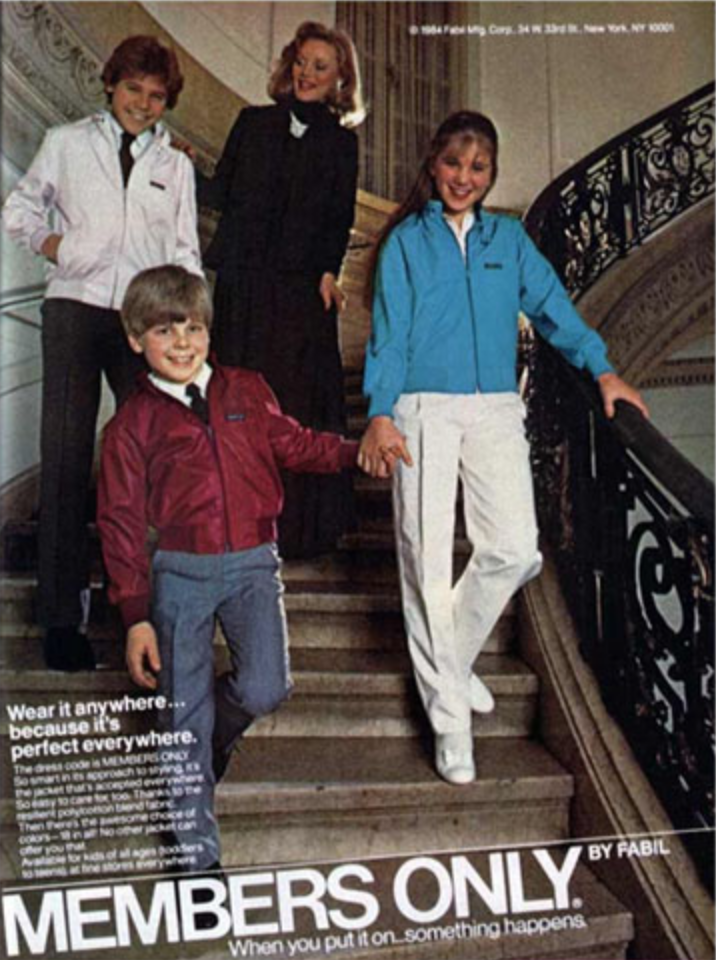
Glasscock: The ad campaign was so self-serious that in retrospect, one had to think they couldn’t possibly be serious — the seeds of irony were sown.
Kelshaw: The jacket came to really signify this inward social turning, this kind of privatization. It was a white, suburban response to the anxiety of globalization manifested by the Reagan administration. That a jacket with the brand-name “Members Only” gained popularity among this demographic group says a lot about the era’s emerging values of exclusivity, privatization and wealth-based social status. I mean, it was a cheap jacket — it was 55 bucks. When they designed them in those multiple colors, they had some conflict with the department stores that were selling them, because they didn’t have the kind of rack space that would show them off.
So it’s appropriate that the brand was built upon celebrity endorsements, with early ads featuring General Hospital star Anthony Geary (and, subsequently, other celebrities) saying, “When you put it on, something happens.” But it’s particularly interesting that, in 1986, the company replaced its conventional advertisements with anti-drug quasi-public service announcements, in line with the Reagan administration’s “Just say no” initiative. Nancy Reagan even sent a letter of appreciation.
Just as the Sony Walkman was a white, suburban response to the African-American, urban boombox (or “ghetto blaster,” as the suburbanites tended to call them at the time), the Reagan administration’s anti-drug campaign and the Members Only public service announcements were, in ways, a manifestation of white suburban anxiety. Crack cocaine was the epidemic drug of the moment (circa 1984-1985), and it was essentially an urban, African-American affliction. Just as fences and gates insulated white, suburban, affluent communities from the dangers of the cities, the anti-drug PSAs were, in a sense, a similar kind of attempt at insulation.
Peak Members Only
Throughout the 1980s, the Members Only jacket experienced unprecedented success — the symbol of white-collar, aspirational success.
Catton: I know throughout the 1980s it was really hot, and over the years, it really hasn’t changed much. The brand revolved around that one jacket, the iconic jacket. It made the iconic jacket the number one selling jacket of all time, just because the same jacket’s been sold from the 1970s until today.
Kelshaw: It represented the rise and peak of yuppiedom that happened during that early period of the 1980s. It was kind of a slow rise, then we had the invention of the car phone, the mobile phone and the fake car phone, which interests me greatly because that ad tag said something like, “It’s not how much money you have, it’s how much money you look like you have.”
Catton: It reached $150 million in sales by 1990.
Glasscock: Sales of the Members Only line peaked in the 1980s at anywhere from $100 million to $200 million, depending on whom you ask. It was popular enough for multiple companies anywhere from Florida to South Korea to try to smuggle counterfeit jackets to market. It was popular enough to launch a fragrance in 1985 with a $2 million marketing budget, which featured a Members Only jacket unzipped to reveal the fragrance bottle.
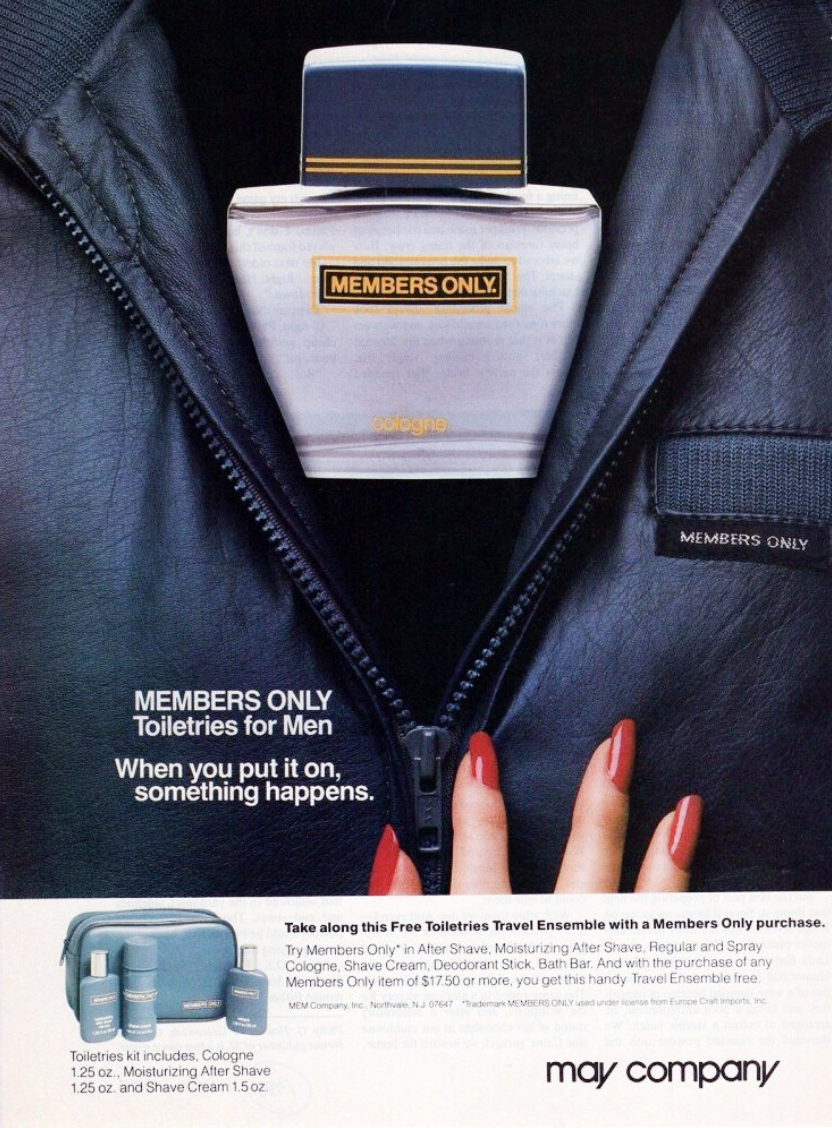
The Downfall
The 1990s weren’t good for fans of the Members Only jacket. Where it was once the symbol of new-age sartorial cool, it quickly became an oversold and all-too-common item. Its popularity became its downfall, and by 1990, the jacket could only be found in discount department store chains.
Glasscock: By the early 1990s, the brand had fallen out of favor. It’s mentioned in the fashion trades, who mark it as part of the stock of Value City department stores, a Columbus, Ohio-based chain that specialized as “a cash-paying buyer of excess inventories.” “We buy after everyone else is done,” the Value City VP noted. Meanwhile, American cool kids arbiters such as Spin magazine name-checked the jacket to telegraph extreme try-hard style cluelessness. The Members Only jacket was dead to the 1990s.
The Resurgence
Like nearly every other fashion trend turned fashion faux-pas, the Members Only jacket would be resurrected thanks to the unironic taste of millennial hipsters… and Sopranos fans.
Glasscock: All those dead-stock jackets (as well as off-brand imitators like “VIP Only” jackets) made their way into vintage boutiques by the end of the 1990s, and then onto the bodies of the Last Night’s Party generation of aughts hipsters. The ironic revival of the Members Only jacket was noted in fashion magazines like Harper’s Bazaar as early as 2000 in an article featuring young starlets in Fiorucci-styled polyblends. That same year, Nicolas Ghesquière at Balenciaga had his own take on the 1980s with a $1,180 sleeveless blouson jacket styled after the Members Only. Within a couple of years, the vintage Members Only was a feature in a Spin taxonomic image of hipster style, complete with D.A.R.E. pin and moussed hair.
Kelshaw: Every 20 years or so there’s this kind of cultural, cyclical thing. It’s because those people who now have the spending currency are getting nostalgic, so that’s when this retro market opens up. That part way explains the recurrence of Members Only, especially the interest in the original racer-style jacket, which was an iconic early 1980s jacket. I mean, that’s just, like, a phenomenon. We see a 20-year cycle of commodities returning — people reliving their youth and reinvesting in their youth in a very retro way.
Glasscock: The Members Only line went through multiple iterations in the 2000s. In 2002, fashion designer and iconic club kid Richie Rich was tapped to design the line. He noted, “Right now it’s only sold at Walmart. It’s just basic coats that your dad would wear. I’m going to relaunch it for women as an edgy line for a girl on the go.” In 2007, another relaunch was set, with Kelli Delaney named brand designer and creative director. She identified her target customer as Mischa Barton and Kim Kardashian and further enthused, “We have a Members Only Myspace page set up, and the majority of people who joined us are hipsters and scenesters from Young Hollywood.” Soon after, Fergie wore a Members Only jacket to the Sex and the City film premiere. The fashion press noted similar brand revivals in the aughts, like Lacoste, Le Tigre and Munsingwear. As one retailer noted, “It’s always nice to see labels you or even your parents wore as children. Even if, at the time, you may never have wanted to be caught dead in it.”
Kelshaw: When I see students of mine who are wearing shirts from Urban Outfitters — which also helped relaunch the Members Only jacket — of brands that they’ve clearly never heard of, there’s something kind of winky about. It’s not really a full sincerity thing, it’s much more of a self-referential thing. The same could be said for the Members Only jacket. Then again, as one who knows so little about their new design rollouts — I think they’ve really diversified — there are probably serious markets for it.
Glasscock: The Members Only jacket revival of the aughts was embraced by emerging streetwear boutiques as well. It helped to recast the brand from a pure ironic revival of preppie douchebaggery to one of the alternate faces of hip-hop dandyism.
Kelshaw: Again, with that 20-year cyclical thing, now we’re having kids, and we want to connect with our kids in a way that harks back to our youth. Which is like, “Hey, our kids are little hipsters, just like we were.”
Catton: The brand has sold 5.5 million jackets to date.
Pop-Cultural Icon
Amongst the myriad recent TV and movie appearances, you probably recognize the Members Only jacket from the hit Netflix series Stranger Things. But of course, the jacket cemented its place in pop culture with its appearance in the famed final seconds of The Sopranos.
Michael Mota, organizer of SopranosCon (Comic-con, but for Sopranos fans): People nowadays know the Members Only jacket from that iconic last scene in Sopranos. Obviously, Members Only [refers to] the premise [of what] the whole show was about — being a member of this society, in that life. The fact that he’s wearing a Members Only jacket, that [was] something people relate to very much, like playing “Don’t Stop Believing” at the end. You know, people now think about that song, and they think about Sopranos. The same with a Members Only jacket — when someone sees one and they’re a Sopranos fan, they just think about that last scene. What happened? Did that guy actually do anything? I mean, he was only in the show for like 10 seconds.
Catton: Most of the recent product placement comes naturally, like Stranger Things. We also had Warner Bros. approach us to discuss having Chris Pine wear the Members Only jacket throughout the entire Wonder Woman 2 movie that’s coming out soon. That actually led to us collaborating with Looney Tunes, based off the success of our [Members Only] Nickelodeon collaboration.
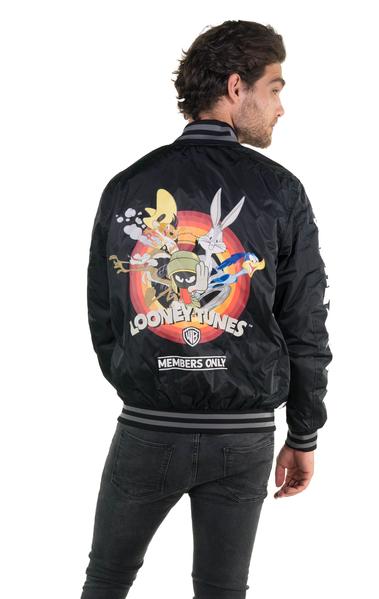
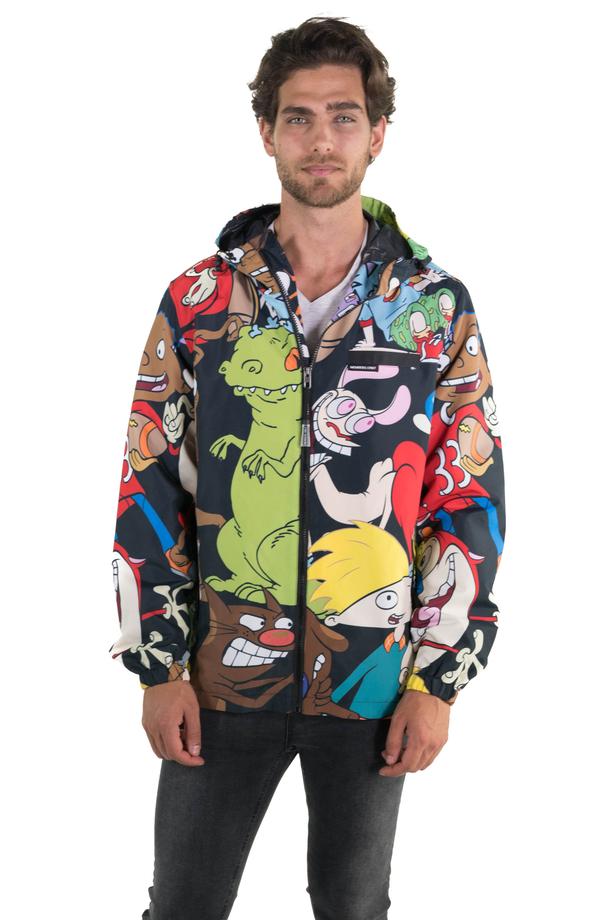 Mota: There’s two iconic jackets in Sopranos: The one that was given to Richie Aprile that he gives to Tony Soprano. Then the other one, obviously, is the Members Only jacket that the gentleman wore who didn’t have a name, who didn’t really have a part, but who played such a big part. That’s what makes Sopranos so unique — there were parts in the show that meant so little, but really meant so much. When I see somebody wearing a Members Only jacket, I mean, the only thing I can think of is no longer the brand — I think of The Sopranos.
Mota: There’s two iconic jackets in Sopranos: The one that was given to Richie Aprile that he gives to Tony Soprano. Then the other one, obviously, is the Members Only jacket that the gentleman wore who didn’t have a name, who didn’t really have a part, but who played such a big part. That’s what makes Sopranos so unique — there were parts in the show that meant so little, but really meant so much. When I see somebody wearing a Members Only jacket, I mean, the only thing I can think of is no longer the brand — I think of The Sopranos.
